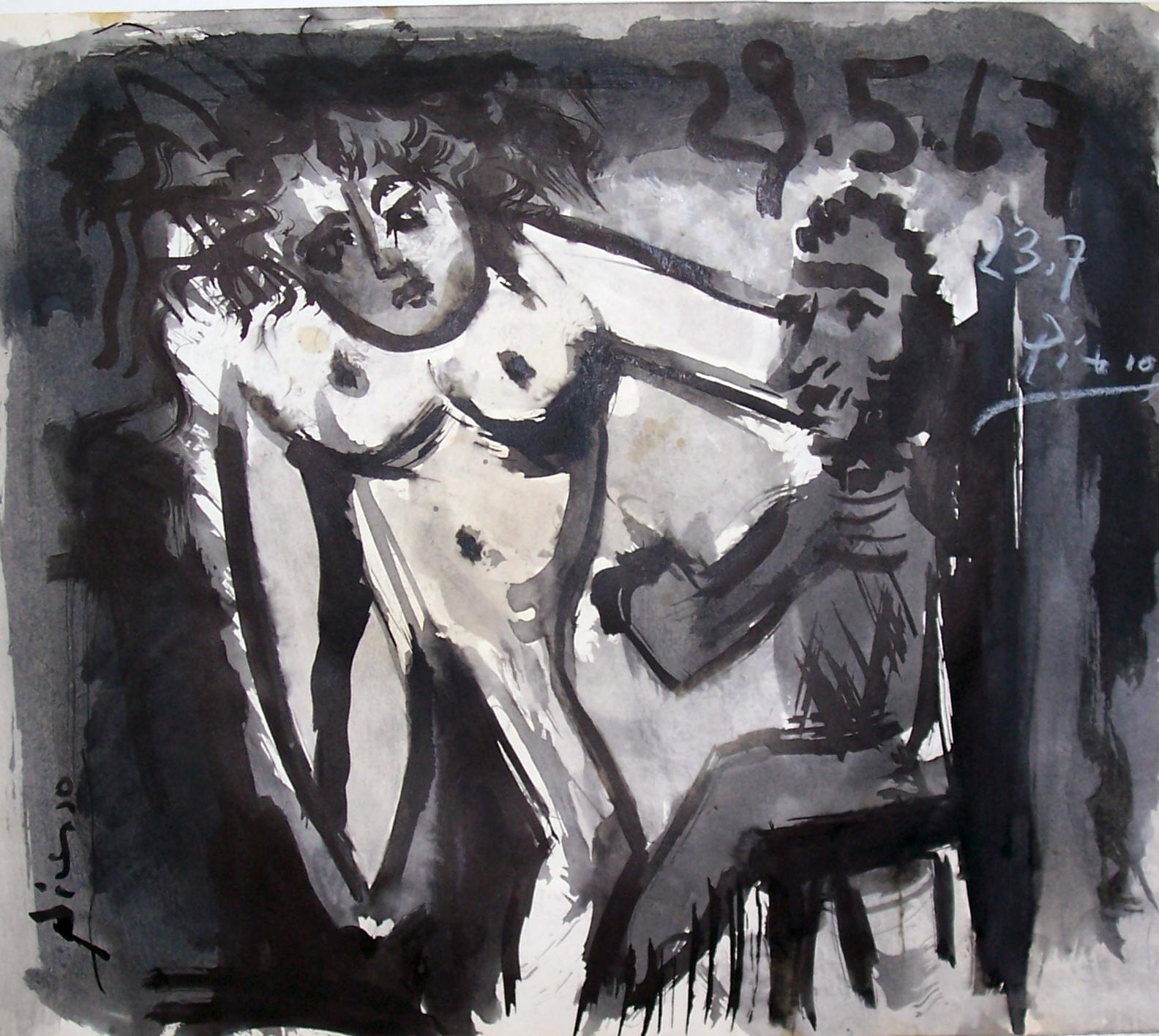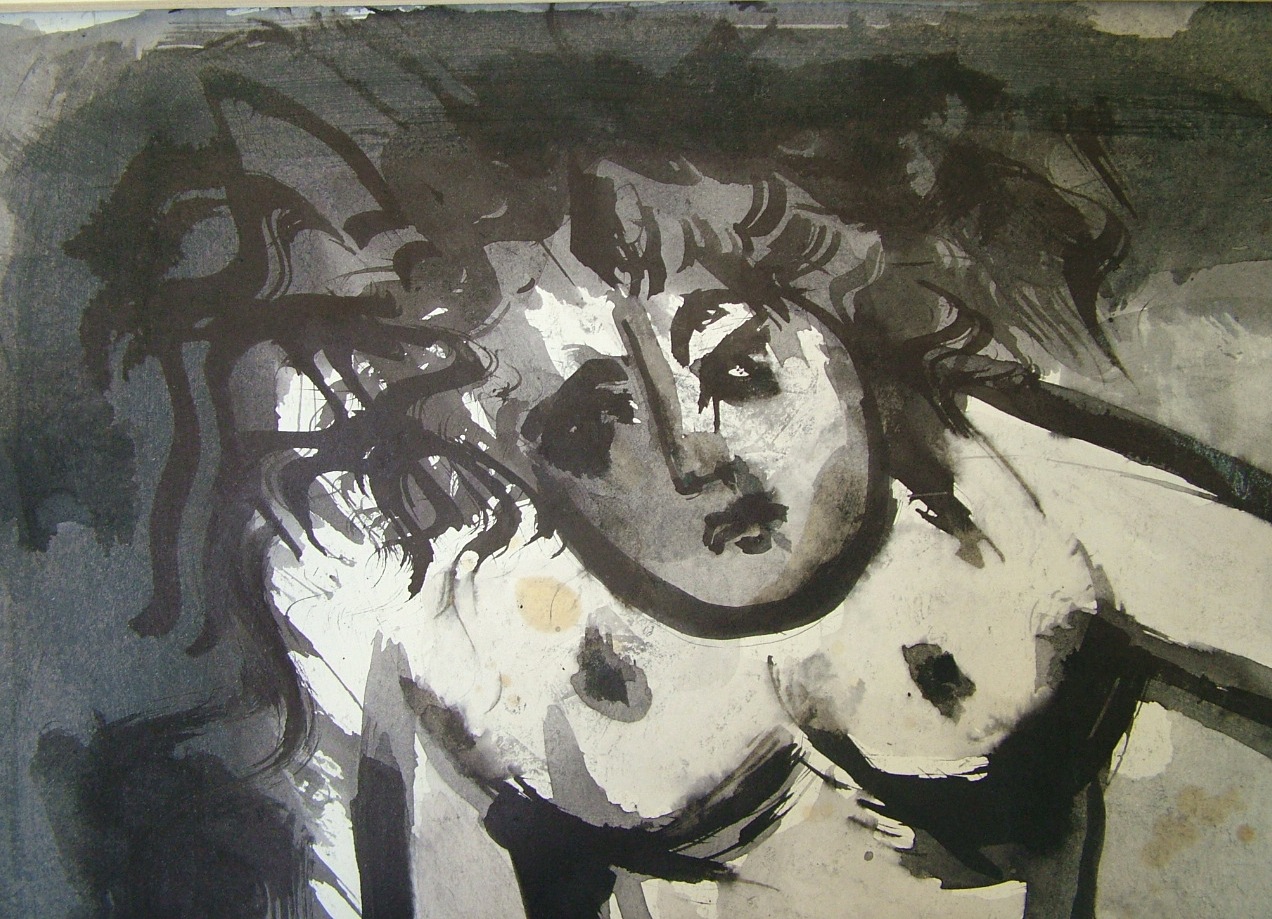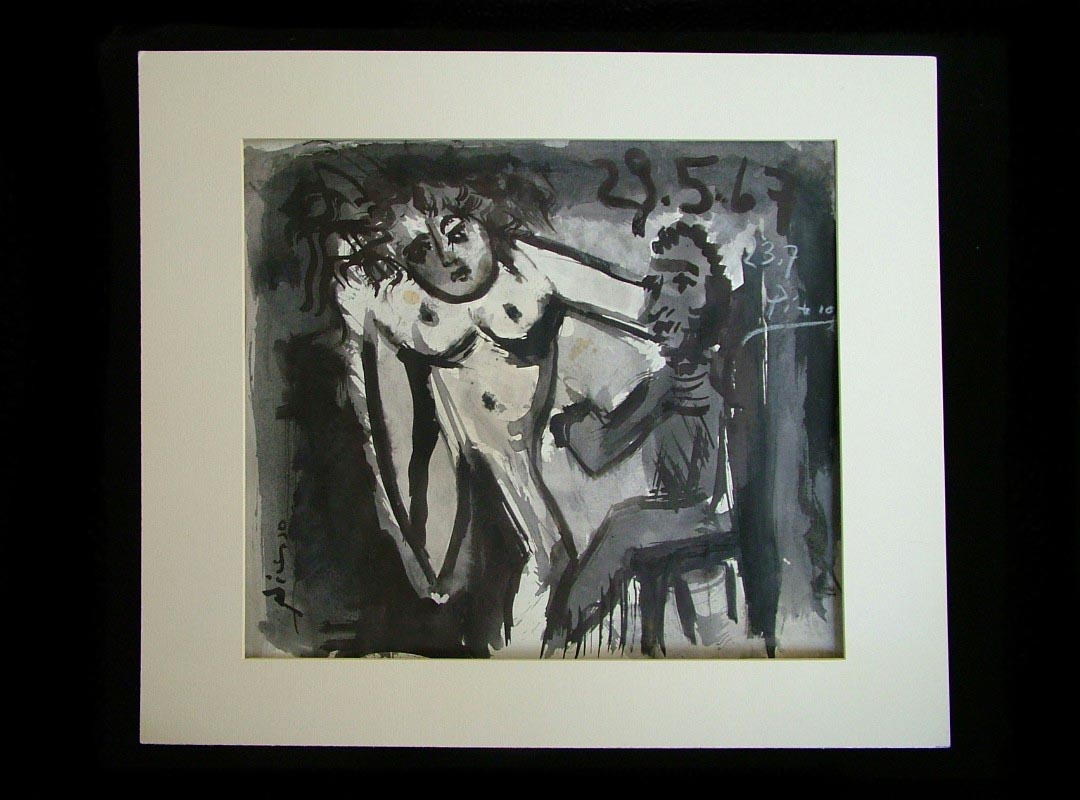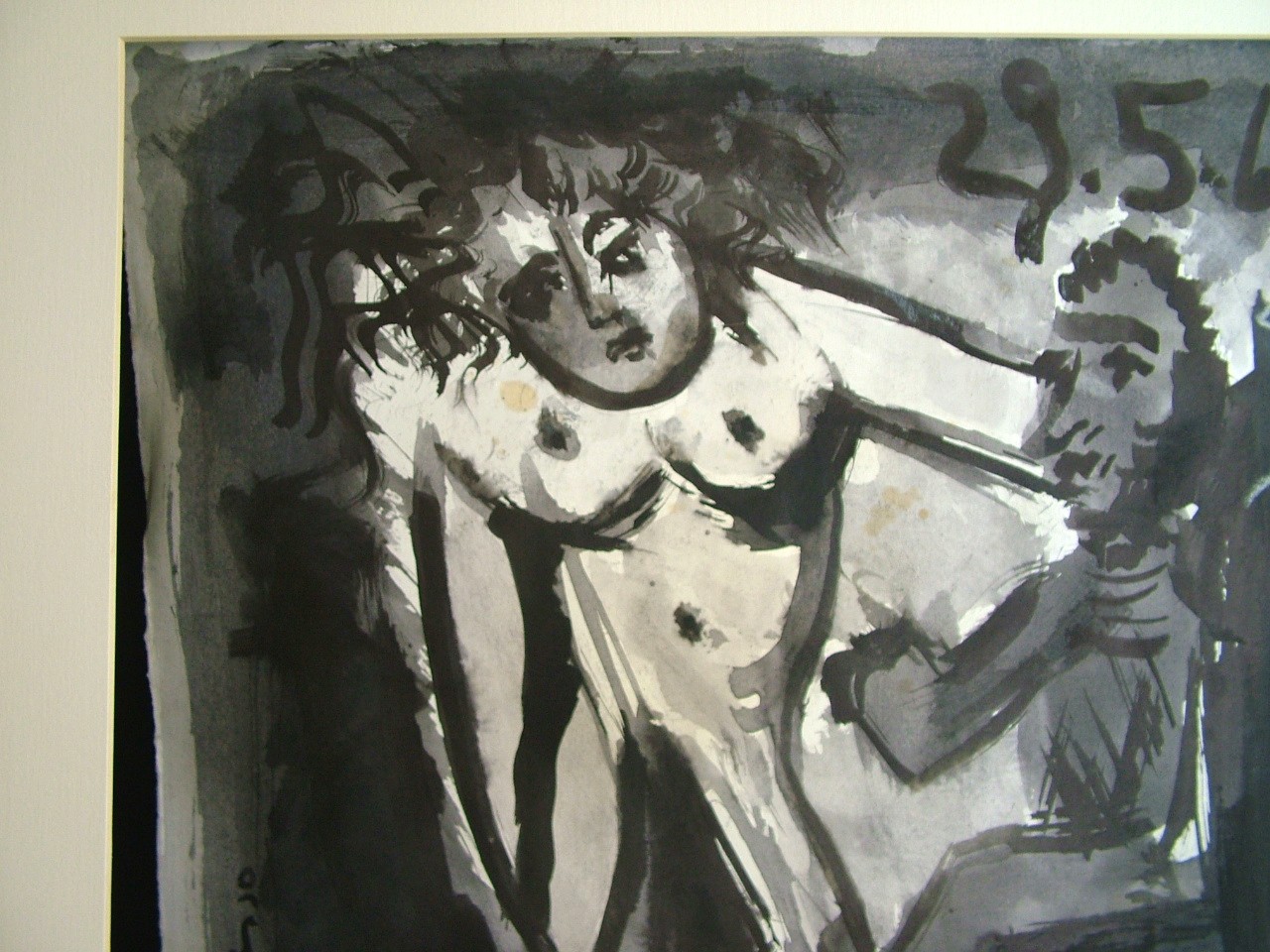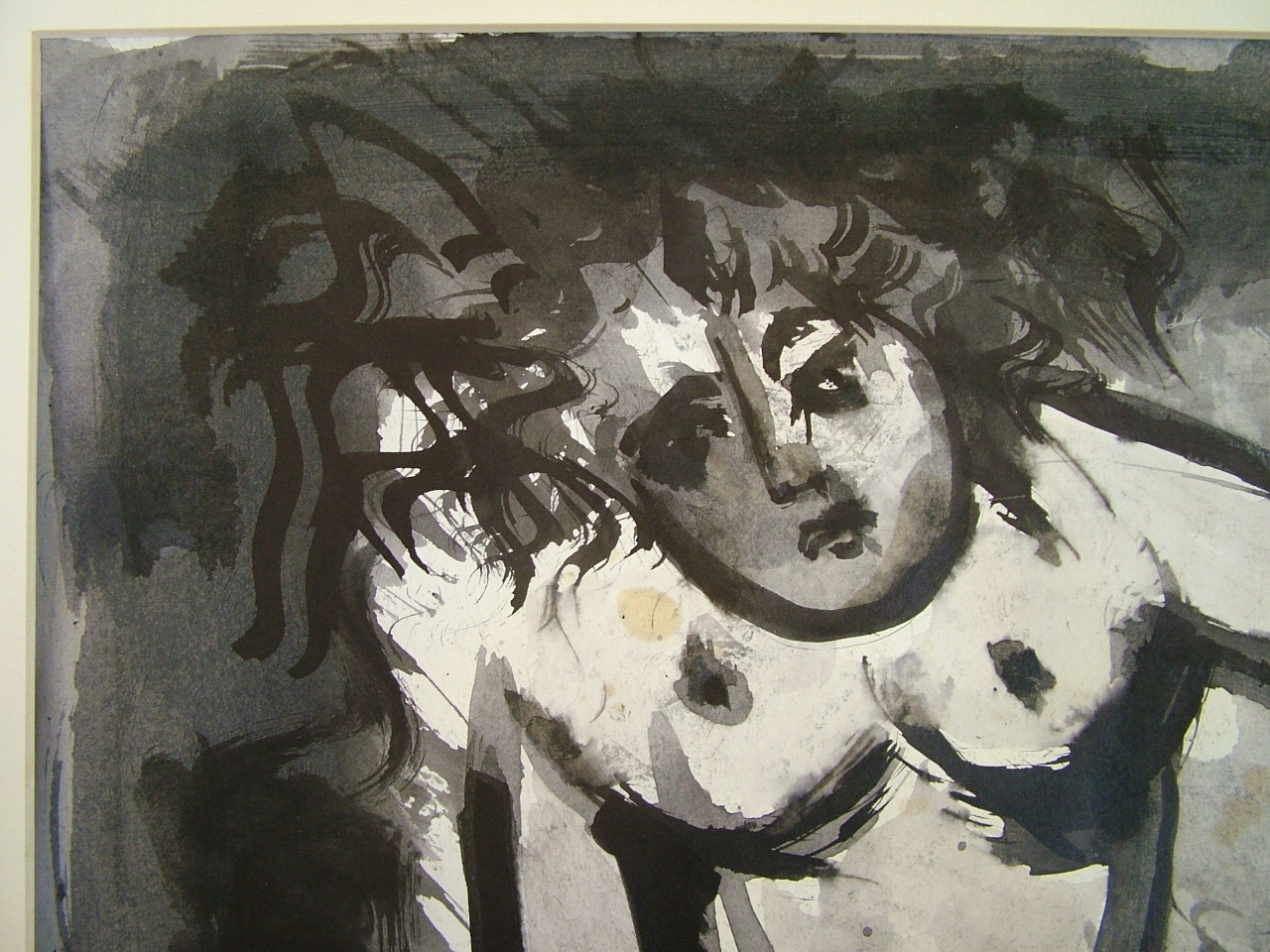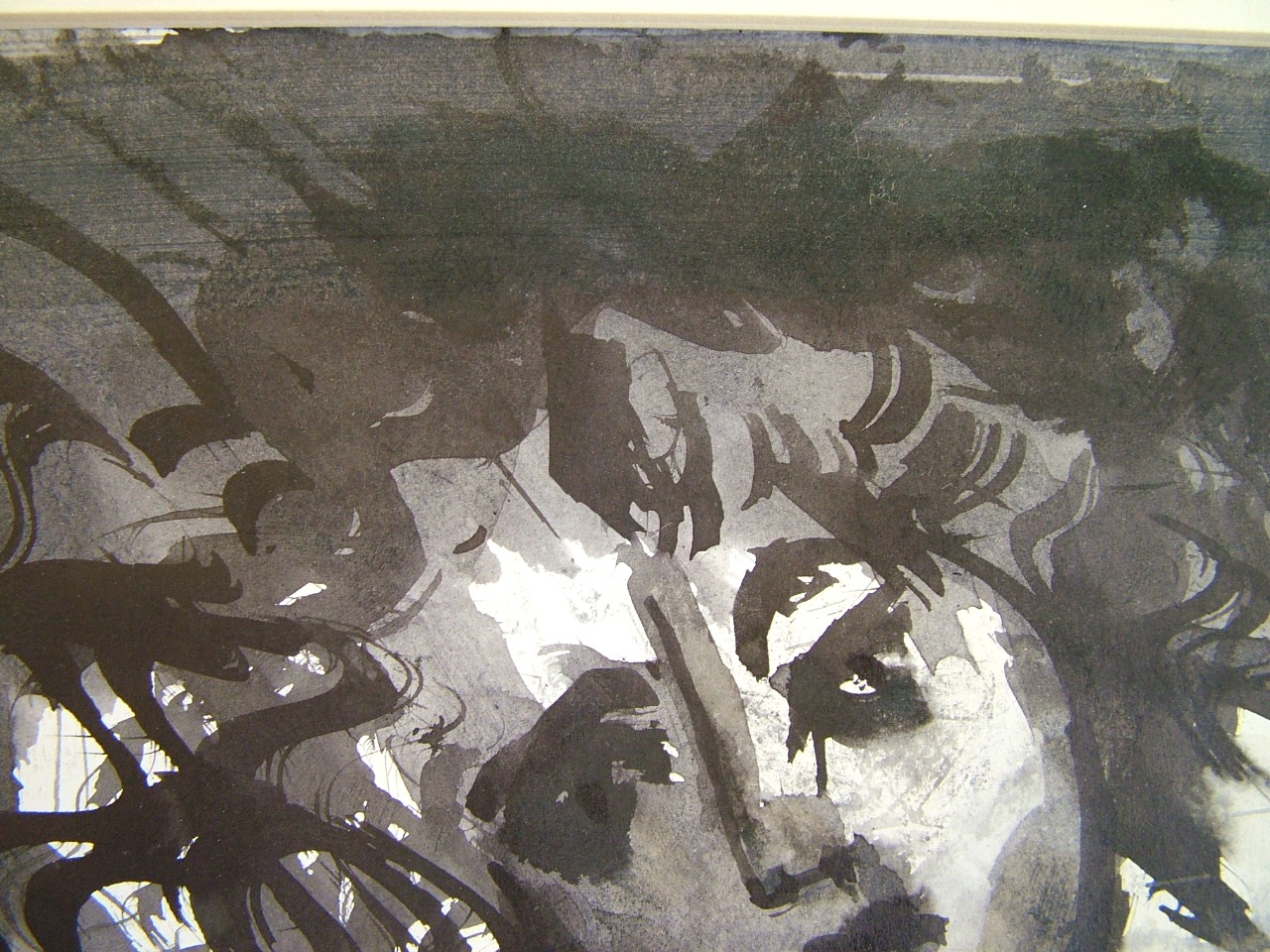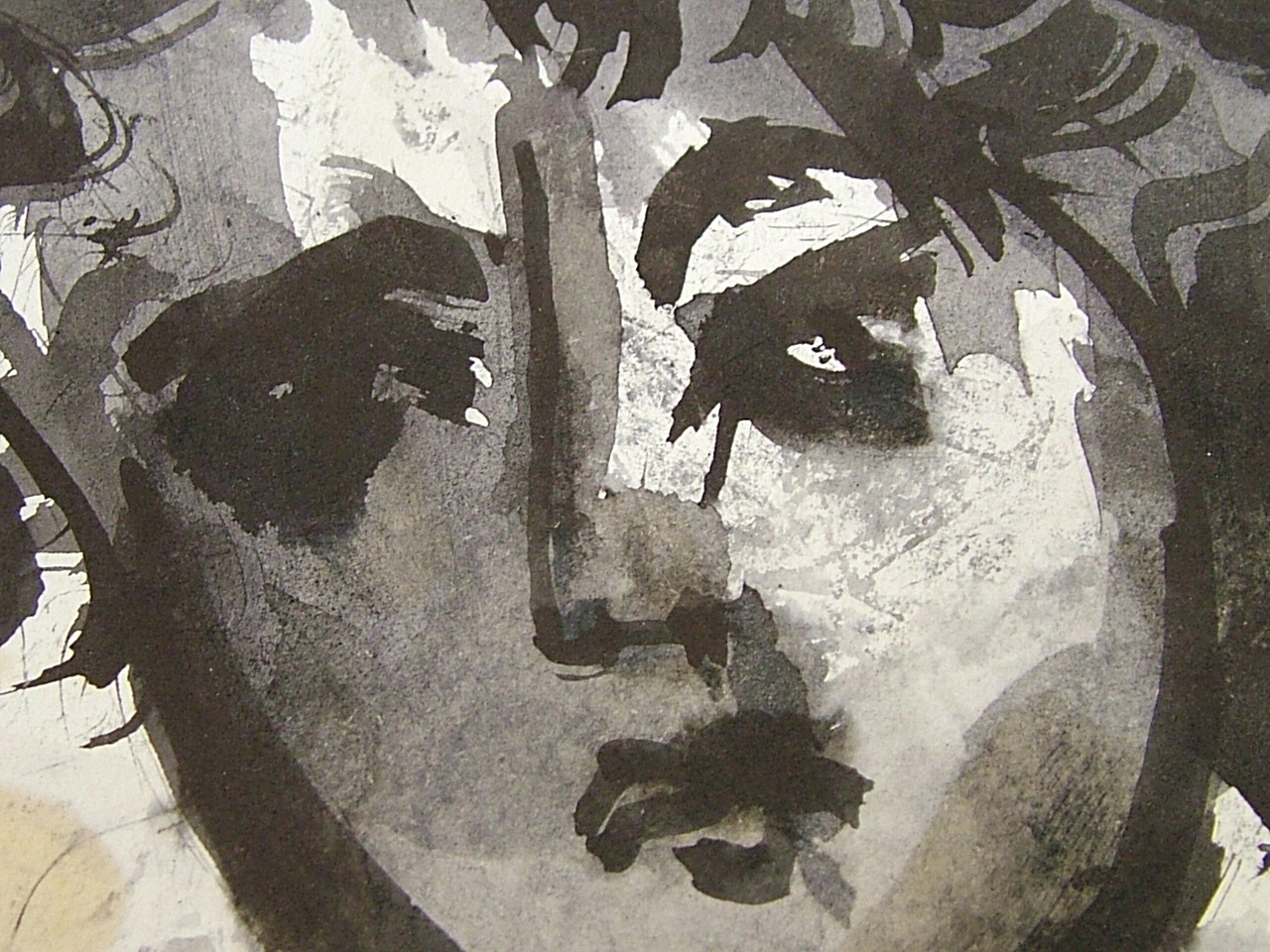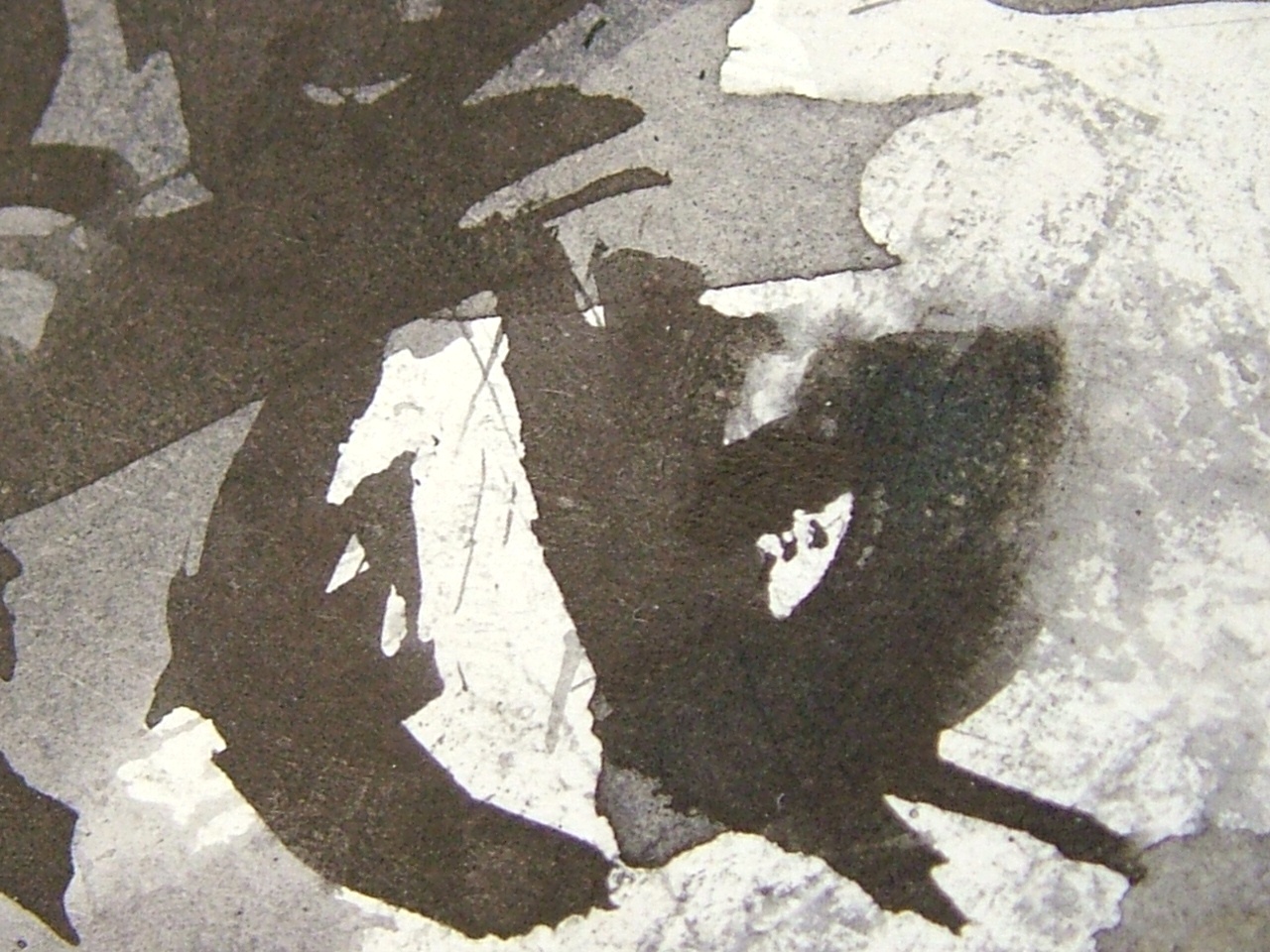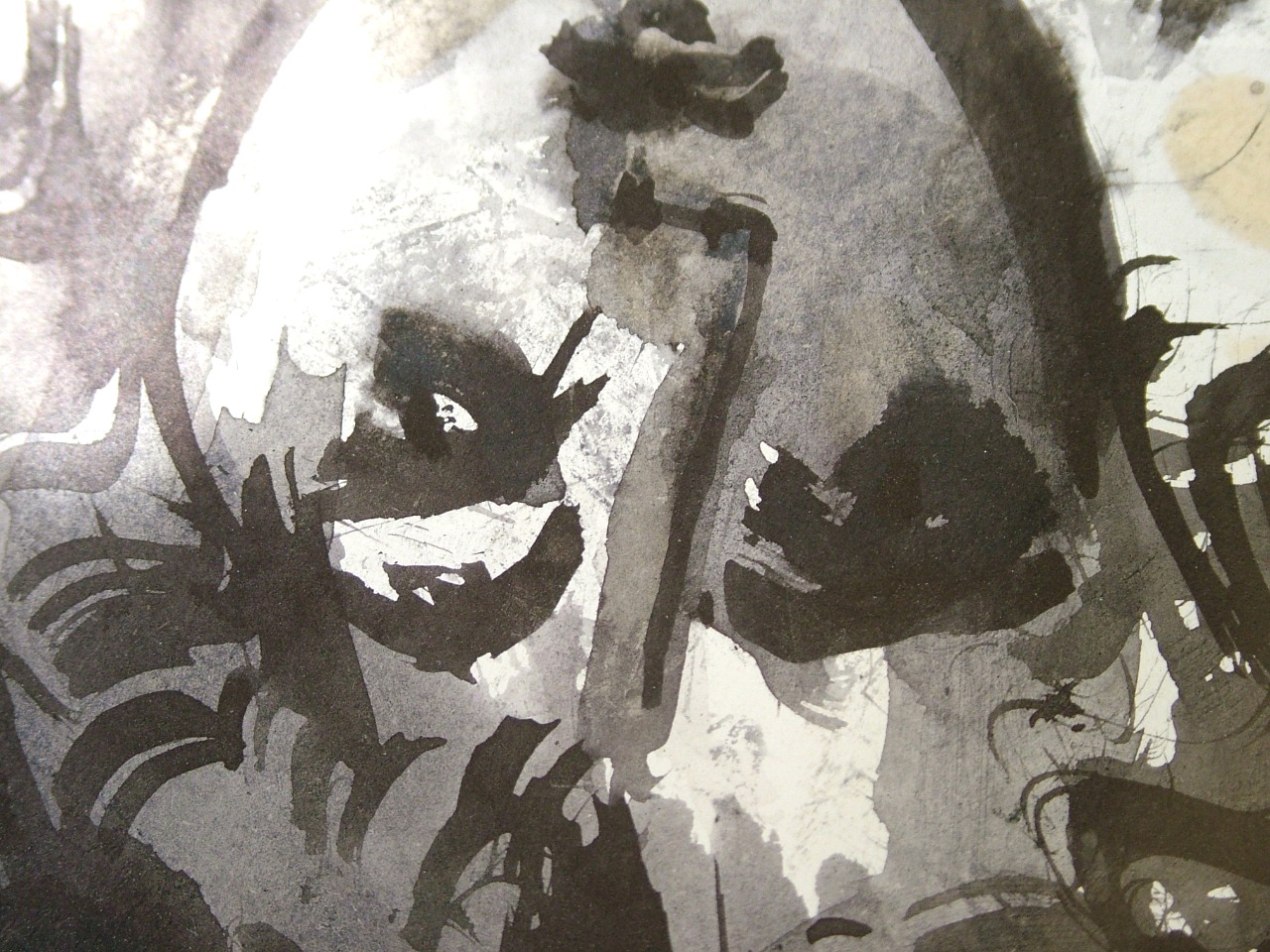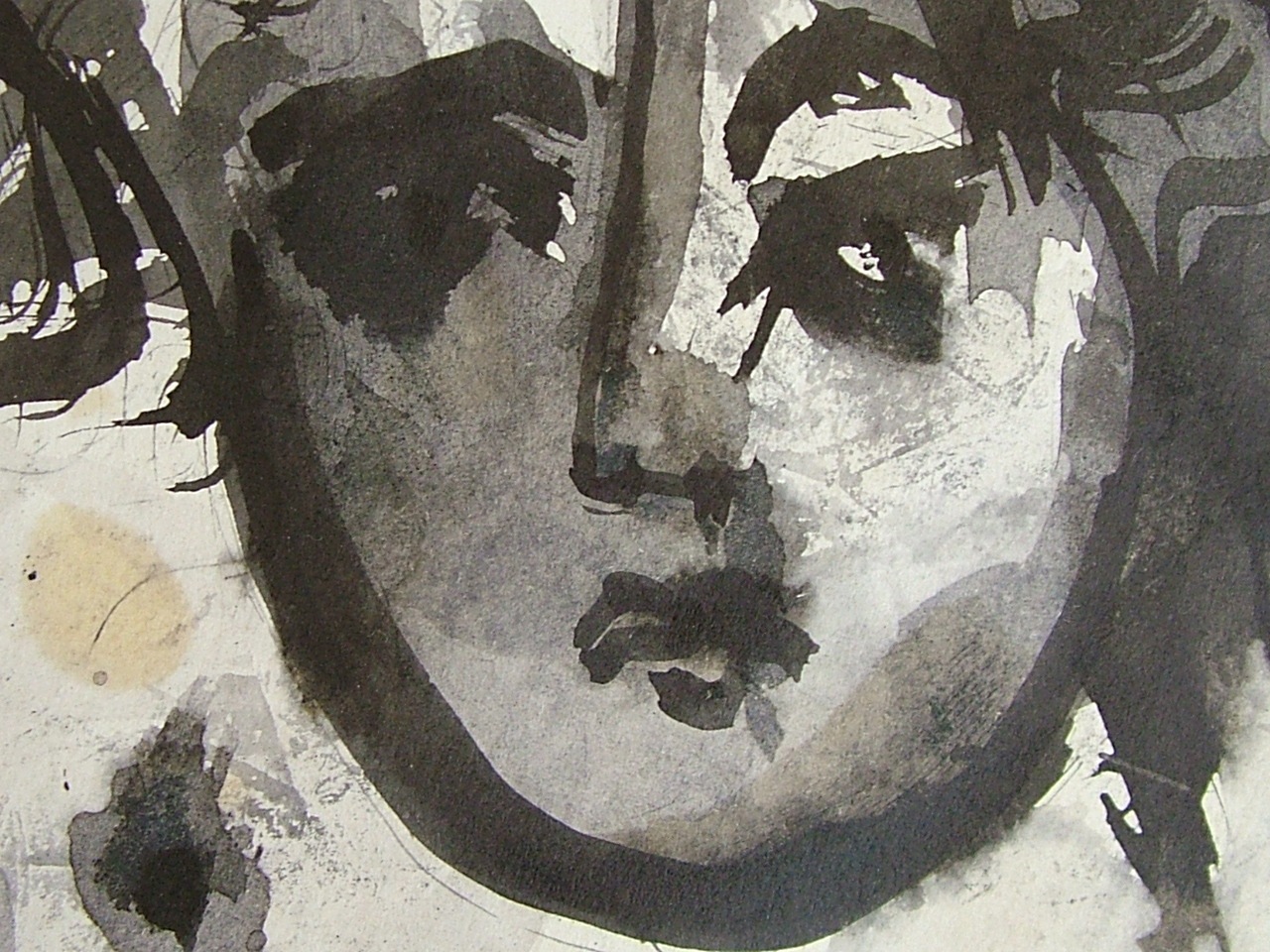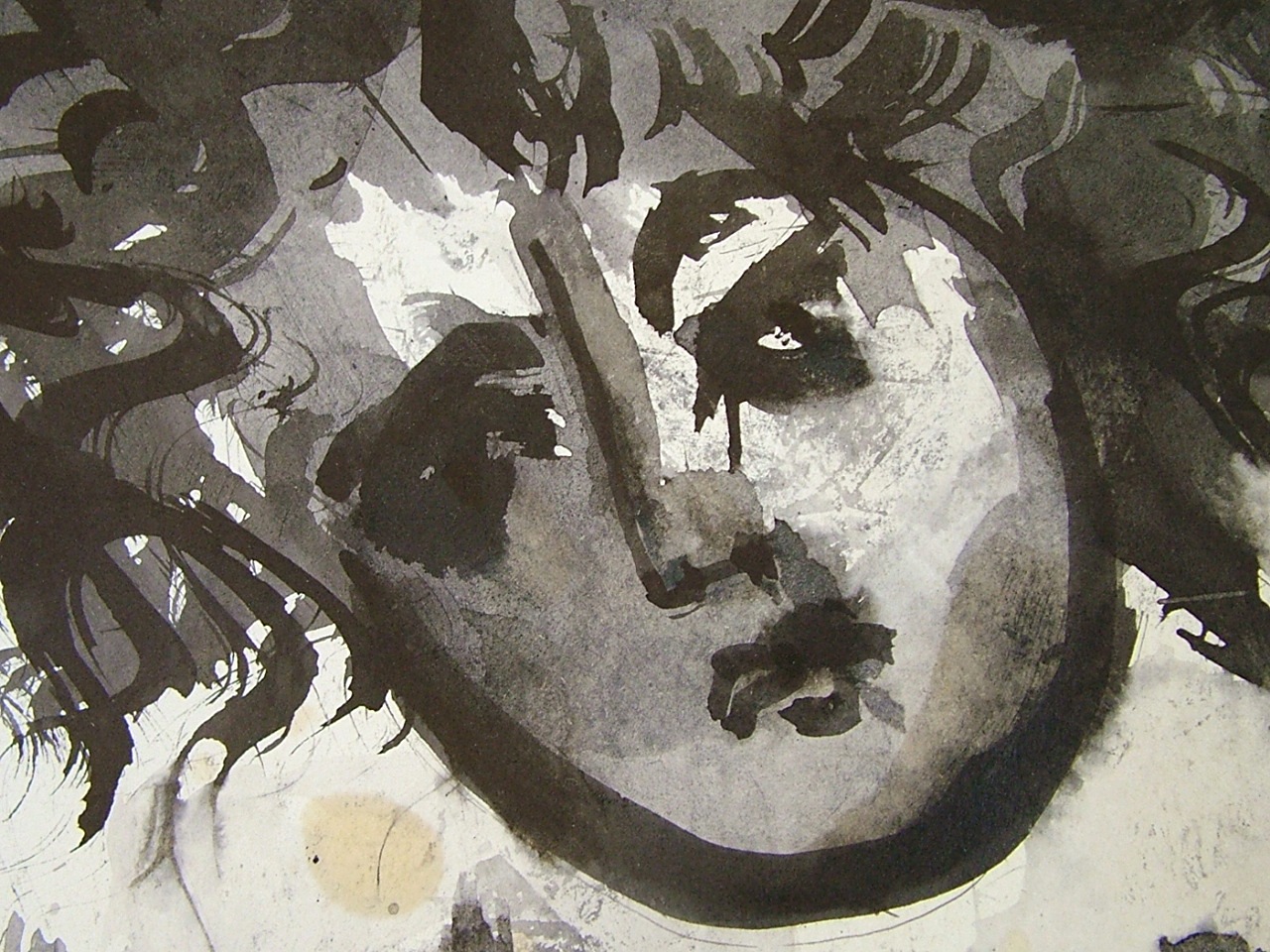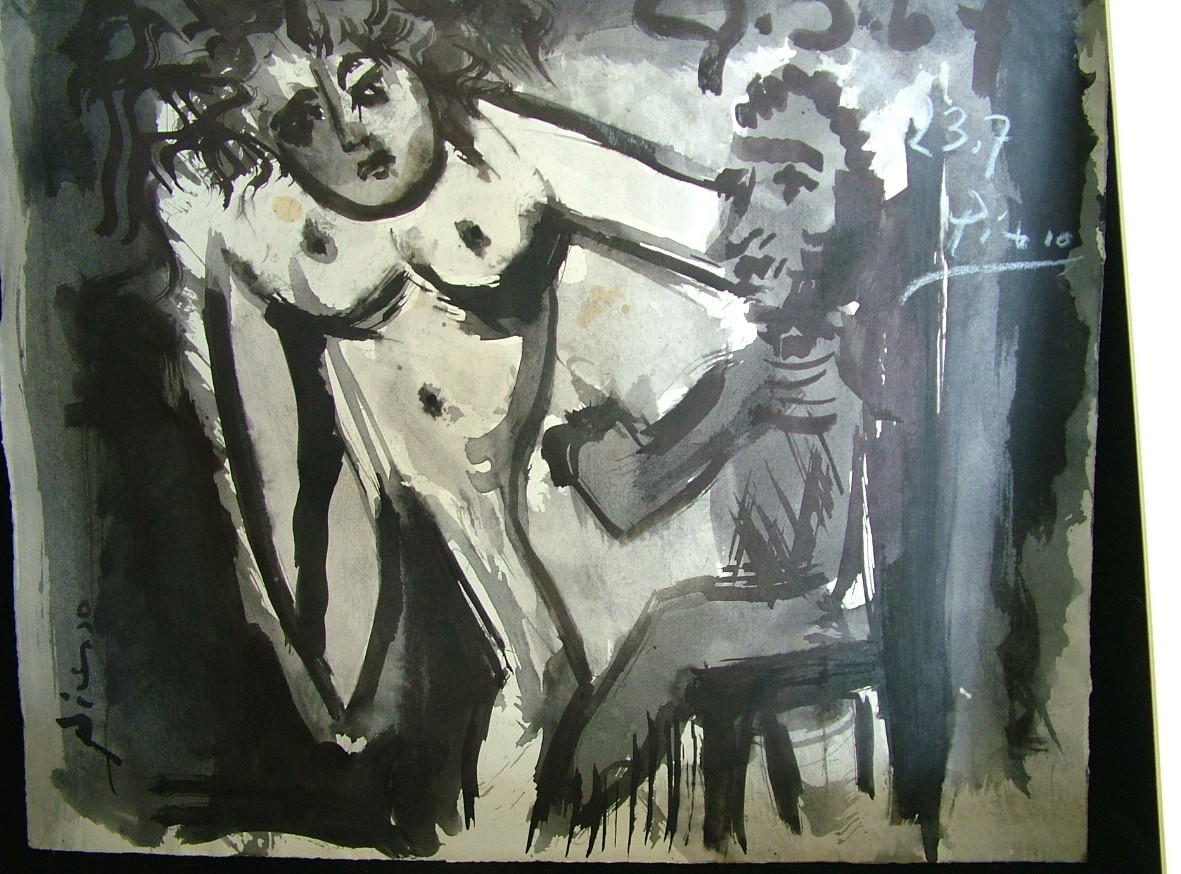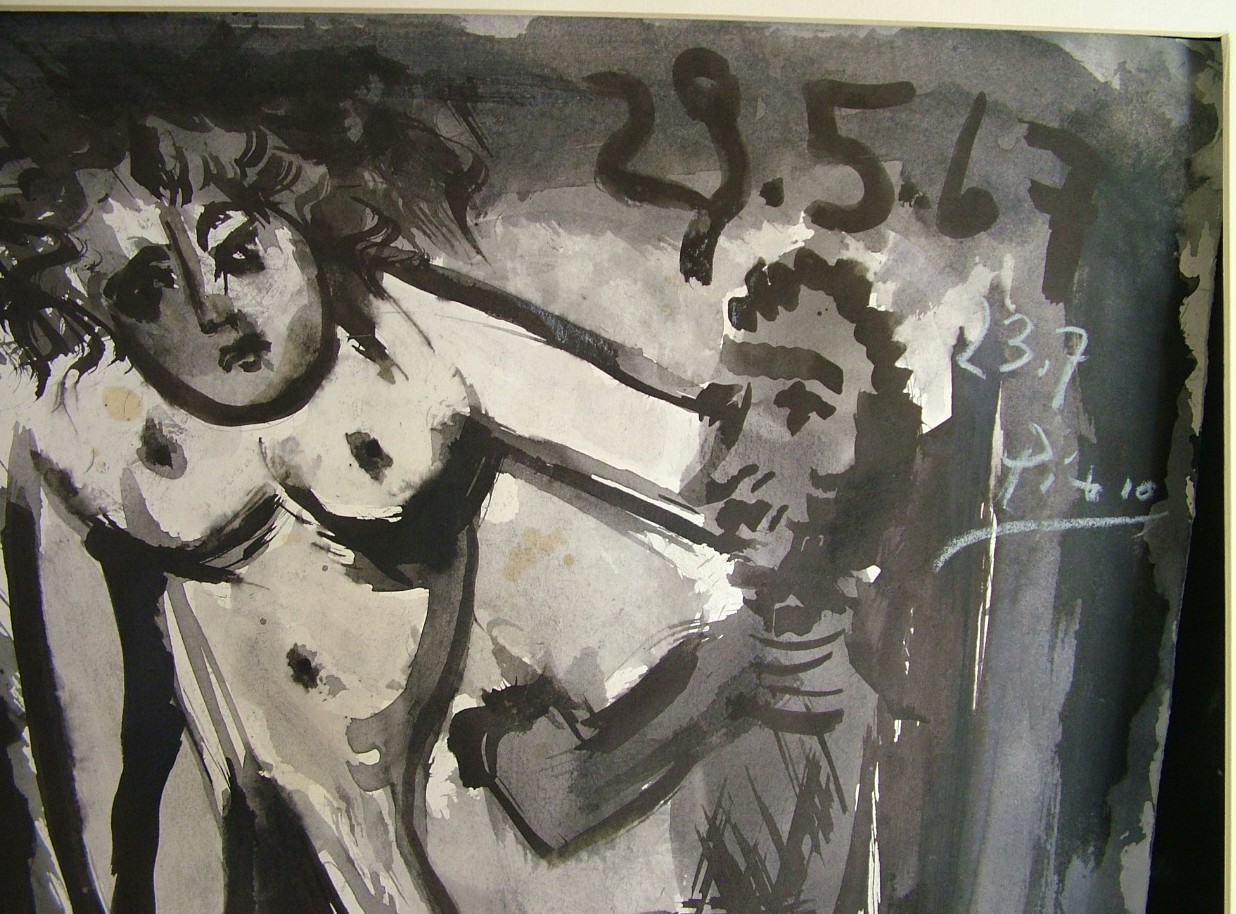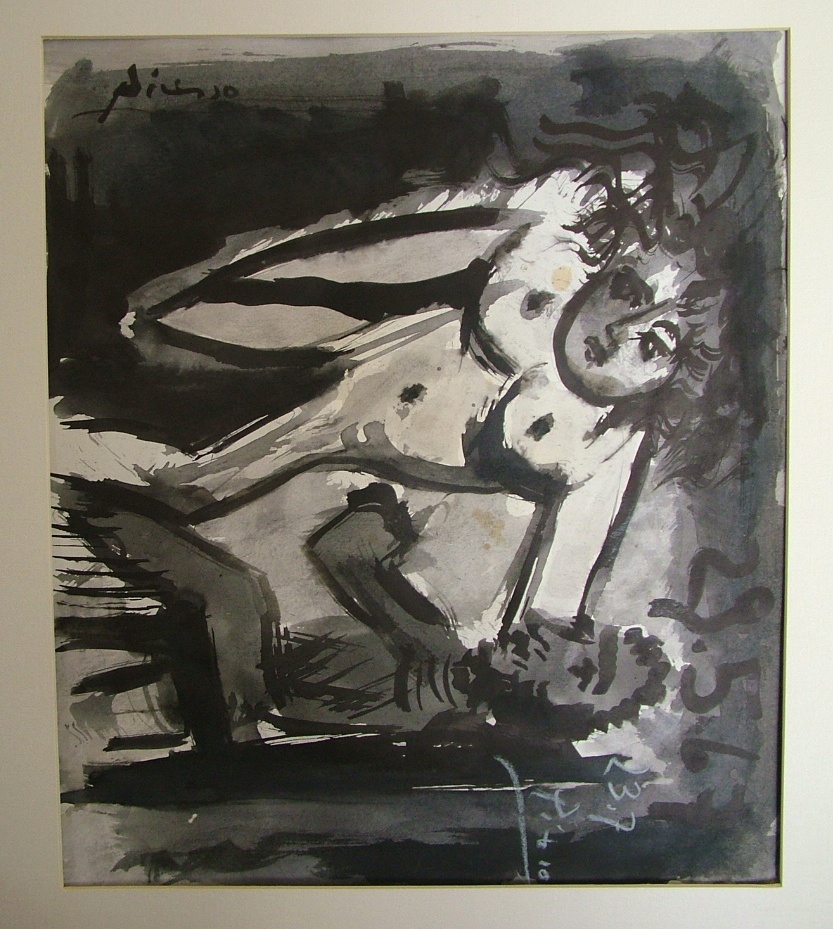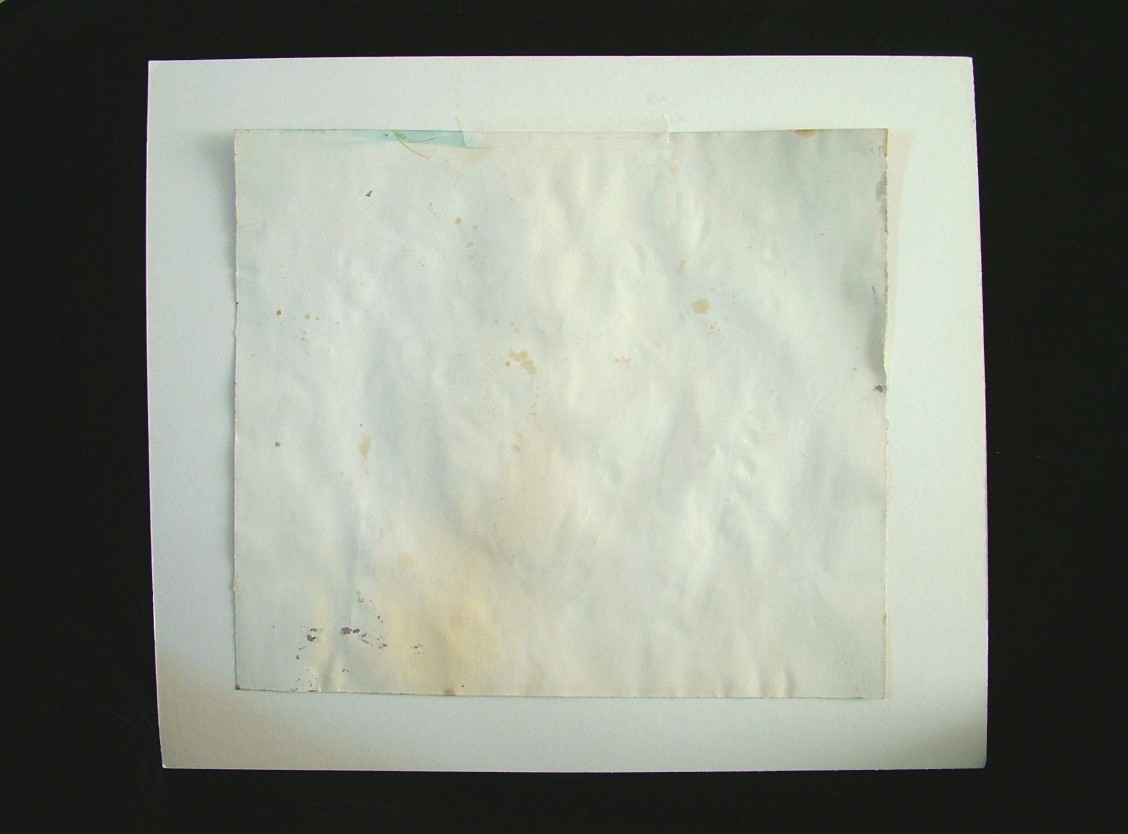 |
|---|
ATTRIBUTED PICASSO GOUACHE ON PAPER |
|
Picture Group 1/1: Attributed Picasso Gouache Overall Description / Hidden Art Depicting Fidel Castro If you are looking for a quick look then I suggest that you view just these two picture groups and their info. only, as the entire posting has many pictures (some that may appear as repetitive, but actually show slightly different details) and more info, and in order to grasp more, then it take a few hours. The info. on this page will be updated on a regular basis for approx. the next month, this also includes at least some improved photo updates (Posted on: 26/4/11). The art and inscriptions on this gouache are of a world wide network of Communist espionage and occultic activities during the 20th C, but with a focus on the 1960's. Some of the summery of the information on what has been found on this gouache is that Picasso had been heavily influenced by the Russian mysticism and the Russian occult, including that of the Soviet Union (this is another area of study, but research shows that the Bolsheviks did in fact have occult beliefs that later those were disguised by the Soviets, what is widely known is that Soviet's were heavily involved in classified studies of the occult and the para-normal) and had that he had been aware of how this had influenced certain high level figures in the administration of Franklin D. Roosevelt. Then that this infiltration had continued right up until the Johnson administration. That "someone" or "someone's" at the NY Times and the New Republic magazine had been at least sympathetic. Then how these and other "assets" had been used to bring havoc with hidden propaganda against the Vietnam War at that time. Then finely how that the City of Chicago had been selected to be the center for the dawning in America of a new age of a Soviet Communist Buddhist styled peace, such a peace was an intellectual's pipe dream as the Soviet's had much darker plans at that time, to my knowledge that information remains unpublished. What complicates things even more is that this all seems to have been part of the second phase of the "Great Game" or the extension of the 19th C. rivalry between the British Empire and the Russian Empire over Central Asia that included to a lesser degree the Americans and the German Third Reich, but supposedly ended with the British Soviet alliance at the beginning of WWII. Although there are no more British or Russian/Soviet empires in my opinion the Great Game never ended (that although in the background that it was part of the Korean War/Vietnam War/Soviet Afghan War) and it continues to this day, but with different players, for those that feel that it was restarted then instead of being calling it phase three of the Great Game they refer to it as the "New Great Game". These first two pictures in this first picture group shows the gouache in a higher resolution but without the matt that it is attached to. The first picture shows it in it's primary position (signature and dates on the upper right) and then the second picture in it's secondary position (signature on the upper left corner). It appears that the later position is for when it has been turned counterclockwise (as to view the art as it transforms) to end up in it's final position. With that this is possibly "the" position as it appears "somewhat" like a magazine or book cover. The rest of the pictures are details are of the face of the standing figure in this position. When close up you will see that there are letters and figures around the nose, and near the nostril under a letter "C" that there is a distinct image of Fidel Castro's bearded face. This alone is of note as Picasso was not known to have ever created an image of Castro, even though there are two known telegrams that have Castro's congratulations to Picasso, the first one in 1961 for Picasso's 80th birthday, and then in 1962 with Picasso's being awarded the Stalin (but renamed the Lenin) Peace Prize for the second time. This is a black and white gouache attributed to Pablo Picasso (1881 to 1973). It was purchased from an art dealer in the Netherlands, there is no other provenance at this time. The gouache is done on heavy white rag paper that has a few stains which appear to be oil or grease stains, it is 36.5 cm x 31.1 cm. It is in an off white matt (not shown with this picture group) and suspended by a vertical strip of tape, the reason for this appears to be that who ever had previously owned this work had known that there is formed art on the back of the paper. It is dated 29.5.67 (29 May 1967) and is signed twice, once in white horizontally on the right hand side, with the numbers 23.7; and once in black vertically on the left margin. It has hidden art (much of it is done in white on white and black on black), there is also miniature art and even micro art. Another important feature of this work is that it appears there are layers of symbolism and meaning with figures, bind letters, and dates. Some of the themes on the face appear to be of various members of the Picasso family, but in my opinion they are a "smoke screen". The most obvious and the only individual that I will mention is his first wife Olga. There is a main theme of smoking (a candle that is also a cigar with black smoke, a cigarette, and pipe). Then there are themes that appear to be of the Spanish Civil War, WWII, the Cold War, mythological, and mystical themes. Besides the bind letters around the woman's head spelling TARN when put with a horizontal "S" and a "T",and then with other letters inside the bind letters, then with the nose that are also the letters "EL" then it reads "ST ARMEL" but also the word "ARM' no doubt that is of "St. Armel, but then along with the "ST" the bind letters also have the letters "AM", this may also be for St. Amelia who is the patroness of shoulder and arm pain. But then there are also the letters "PICASSO. So everything in these bind letters or bind letter abbreviations is connected to Picasso. To make all this even more complex when the gouache is moved in the other three of the four directions then the letters will change to other letters, symbols, and meanings. Due to the date on this gouache and the face on the standing figure then it would appear as having something to do Picasso's first wife Olga as the date of May 29th, 1967 would have been around a 50th anniversary in May of 1917 with Olga and Picasso's meeting and courtship in Rome. Olga was as ballerina with the Ballets Russes and a daughter of a Russian Colonel of Railroads under the Czar, but once with the Ballets Russes she supposedly promoted her father to a Colonel of one of the Imperial Regiments and at other times as a General. She had been a ballerina and he had been a set designer/costumer for the Ballets Russes production Parade that open in Rome on May 18th, 1917, so May 29th "may" have been exactly 50 years for "something" that happened on that date. If so and besides any other factors then Picasso "may" have had a significant disappointment or a resentment that he then later projected with his zeal for Communism and hatred for America (which had supported the White Army in 1918/1919), possibly. This gouache shows a standing figure who has aspects of both sexes in white with an extremely distorted body is facing front and slightly to the left where there is a seated bearded darker figure in profile that is a male, this figure also has an extremely distorted body and what appears to be a smoking pipe. The seated figure is looking forward and slightly to his left away from the standing figure; the standing figure is looking in the direction of the seated figure but not necessarily at him. The standing figure appears to be standing on one leg, holding the other leg bent back and up behind, this is in a pose that resembles that of a ballerina during a warming up exercise on a bar. The standing figure's arm is also a very large cigarette, it is if the arm/cigarette is around the sitting figure but there is also a suggestion of the standing figure having a hand (but in black) that is holding the seated figure by the throat. In this position the image of the standing figure's bent leg that suggests very large female genitalia, but with the other leg there is also a suggestion of penis, this area also has a large dark dragon's head coming from underneath to the left that has a paint brush in it's mouth, the paint brush is positioned as if painting the standing figure's right breast. The dragon's tail is also another phallus and this will be discussed with Picture Group 14. What is extremely disguised are the large letters "NR", this are seen with the lines of the standing figure's bottom half ("N") and the light gray area in between the two figures that makes a wavy large letter "R". Due to other symbols and other info. on this I have no doubt that this stands for the New Republic magazine. There is smaller art and miniature art that is semi-hidden throughout the painting, also this art will transform when placed in the other three directions, but none so much as that around the standing figure's head. Although not shown here the back of the painting has work done in white on white, it also has been formed as to show faces and flowers when viewed at a slight angle. There is also some small dabs of paint and stains, a few of the dabs of paint have micro art, one of these done in sienna and at 2.1 mm in length. Amazingly it is micro painting of figures, inscriptions, and a scene; it will transform when seen in the other three directions. |
|
| |
|
| Picture Group 1/2: Attributed Picasso Gouache Overall Description / Hidden Art Depicting Fidel Castro This group of pictures focuses on the standing figure's face in various positions moving from right to left. The first detail focus is the figure in black holding two white horns with a white bull's head behind him, the figure is also the right eye. The right eye black figure is of Picasso as a Warrior Shaman. The bind letters "UN" can be seen with the bull, this should stand for the "United Nations", but also this can be seen as a "NY" (with the "Y" slanted to the right) and with the larger gray area of the nose a large letter "T", this should stand for the New York Times newspaper. The horns that the right eye figure/Picasso as a Warrior Shaman is holding is being pointed at the lips that are also the bind letters "SC", but also "SEC", this should in French stand for "Secret" and perhaps "Secretaire", this appears to be something to do with the Spanish Civil War and, or Franco's regime, and possibly also WWII. With that said also with Castro's female comrade Celia Sánchez, if so then the large white face with the black eye (or even the larger woman's face in profile facing to the left) may in fact be of Sanchez, there are those that claim that she was the real brains behind the Cuban Revolution and the primary strategist for the Granma Expedition, also that she was heavily into witchcraft, and of all things, fashion. This is further discussed with Picture Group 13. The second detail focus is the white face with a black eye (that is also the left eye) on the left of the face. The white area is of a ship holding a pyramid with a flag, the ship is also a sugar scoop, under the ship is a curved machete. This ship is in fact the Granma. The Granma is a 60 foot white yacht that had been purchased by Castro who had been training Cuban revolutionary guerillas (of the "26th of July Movement") in Mexico, this was in order to transport the expedition across the Gulf of Mexico to Cuba, then with local reinforcements lead a revolt against the Batista regime. On 25 November 1956 , the Granma with eighty two members of the "26th of July Movement" left Tuxpan, Veracruz, Mexico aboard the Granma for Cuba. They were led by Fidel Castro along with his brother Raúl, Che Guevara and Camilo Cienfuegos. It became known as "The Granma Yacht Expedition".. They landed in Playa Las Coloradas, Municipality of Niquero, Oriente Province (after 1959 named Granma Province) Cuba on December 2, 1956 and so began the Cuban Revolution. Although the majority of the expedition was eventually chewed up by Batista's Army, there were twelve survivors of the original eighty two; this included the Castro brothers, Guevara, and Cienfuegos. So the revolution/insurgency continued until Castro triumphed when Batista fled on Jan. 1st, 1959. In that same year Castro looked to the Soviet Union for support and a hundred Soviet Advisors were sent. By 1960 the Soviet's were becoming entrenched in Cuba, Castro received the Lenin Peace Prize in 1961. With the exception of the Bay Of Pigs and the Cuban Missile Crises Castro's regime was seen by some Western intelligence analysts as a type of side show during the Cold War, and by others as a small but extremely vicious enemy that focused on "exporting", and all with the approval and support of it's big brother the Soviet Union. Needless to say the path to victory began for Castro and Co with the launch of the Granma expedition. The Granma along with it's name is an important symbol for Cuban Communism, among other things it is the name of the newspaper of Central Committee of Cuba's Communist Party. The Granma yacht itself is housed in a glass enclosure at the Granma Memorial next to the Museum of the Revolution in Havana. The name Granma is Cuban slang for grandmother, although in fact the original name for the yacht appears to have been in English "Grandmother", it was sold by an American based company. The third detail shows the standing figure's face upside down and shows a figure that is as if loading a mortar, on top it has a letter "C", but overall is the number "51" as in 1951, just like everything else there is much more to this that will be shown and discussed in other picture groups, but I assure you that this symbolizes Picasso as a sorcerer projecting as in "making" Castro the Baseball Picture hit a Batter in a 1951 Cuban Winter League game. As in believing that this event had sealed Castro's fate as a revolutionary and a champion of Communism vs a profession in baseball, it also appears that there is overlapping symbolism with the Chinese Communists and the Korean War. The rest of the pictures shows the area that has Castro's face that among other things is connected to a lit cigar. |
|
|
|
|
| Picture Group 2
|
|
| Picture Group 2: This group of pictures shows the work but with the matt, some of the details, details of a manuscript or a magazine, the standing figure's left breast, the right breast, a white bird's head with a large eye, and a dragon holding a paint brush with it's mouth (that is painting the bird's head), then a white area with figures that are also a scene on the dragon's throat. The magazine is very lightly done so I expect that it contains some important information, it has figures, scenes, numbers, and letters. As of yet I know that the magazine or manuscript has a large head (with many figures it) that is also a volcano with a cloud like a smoke ring near it's mouth, it has an art and inscriptions that require more study. With the white bird's head being painted by the dragon, there is little doubt that this is one Picasso's famed "Peace Doves". The dragon's tail that is on the right is also a large dark phallus, this has a crutch near the top that is also a letter "T", the crutch in art is usualy associated with Salavador Dali. There is more with this that will be discussed in the info. with the next picture group. When this is seen with the dragon at a distance it suggests a very large letter "U", then the light gray area in the center forms a very large letter "S", then the standing figure (who remember among other things represents Lady Liberty) forms a tilted (to the right) very large letter "A". So if I put this together with the basic inscription on the standing figure's hair then the actual title of this work is something like "MY (Picasso's) CAMOUFLAGED MAGAZINE (Message) TO THE USA". In my opinion on May 29th, 1967 this message was meant to be seen as a brag or a command, or both. |
|
|
|
|
| Picture Group 3
|
|
| This group of pictures shows other details of the standing figure, there is a scene on top of the face of figures in smoke and a dark baby (there is more on this with the next picture group), details of the standing figure's face, details of the top and of the numbers. The details on the lower half show that the standing figure is also on a black crutch (Dali would have been pleased). The details of the dragon's tail that is a large dark phallus shows that the top has the letters "ST" (as mentioned before the "T" is also a crutch), under this is a large "P", but if this is seen at a slight angle then the letters "SOV", so the ST can not be a Christian saint with a name begins with the letter P, so it appears that Picasso of all things thought of himself as a sexualy charged "saint of the Soviet Union". Under this there are various figures and then to the right a type of sphinx. |
|
|
|
|
| Picture Group 4
|
|
| This group of pictures also shows the face of the standing figure, then a scene on top of figures in smoke and a dark male baby with a woman's head and a suggestion of a sexual act. The baby may be an African and is as if being placed or thrown into a web or a cage. There are more details of the standing figure's head, such as it shows the nose is a candle but also as a lit cigar. A baby connected to a cigar and smoke is important as it was reported that Picasso had been born stillborn, and that a puff of smoke from his uncle's cigar made him cough as to then take his first breath. This pictures also show a face in profile as part of the standing figure's face, although I am still working on this, who this woman may have been should be significant . |
|
|
|
|
| Picture Group 5
|
|
| This group of pictures shows the bind letters with scenes and their transformation in the other three of the four directions clock wise. As mentioned previously the bind letters when seen in the primary position are abbreviations for "TAR", "TARN", TARANEL, and PICASSO, but the "ST", "ARMEL" and "AMELIA" should also represent the Catholic saints Armel and Amelia: The name Armel is from Arthfael which in Welsh Breton means "the bear king". St. Armel was an early 6th C. AD Breton from Wales who founded abbey's and churches in Brittany, legend states that he defeated a dragon at Ille-et-Vilaine by forcing it to drown itself, there are some that connect this saint to Arthurian lore and others that even theorize that he was King Arthur, that is after he had retired from Britain. He is usually depicted in armor beneath a chasuble and with a dragon with a stole around its neck or at his feet. He is the patron of healing headaches, fever, colic, gout, and rheumatism. The bind letters also have the letters "AM", this may also be for St. Amelia. The 7th to 8th C. St. Amelia (Latin for "industrious" but as a saint "industrious for the Lord" )or St. Amalberga of Temse. Flanders Charlemagne was intrigued by Amelia who wished to become a nun. He pursued her for seven years when at some point when he wished to wed her she locked herself in a church, when Charlemagne tried to remove her he broke her arm accidentally, but Amelia prevailed and then her arm miraculously healed in hours. Even then Charlmangne did not give up and tried to woo her with a "bear skin" from a bear that he had killed near her convent, but again she declined. Later when he became ill she went to him and he was miraculously healed. She is connected to a legends of her crossing the river Escant on the back of a great sturgeon and later when she died then of having her funeral boat escorted by sturgeons to her place of burial in Temsche (at a church she dedicated to St. Mary). She is sometimes depicted standing on top of a sturgeon as if riding (so she should also be the patroness of surfers) and is a patroness of healing arm and shoulder pains, fevers, and farmers, and fishermen. So both these saints have some connection to lore to do with bears. When the bind letters are seen in the next position may make the letters "ES" as an abbreviation for Spain in Spanish, but more certainly they appear to make the letters "SAG", or "SAX", or "SOE". This may represent the English words "Saga", or "Saxon", or the "SOE" (Specials Office Executive (the British Special Operations Branch)) of WWII. This has something to do with the Spanish and the English, and most likely just prior to or during WWII. There is a Musketeer that appears to being hit by the face of the standing figure. I have every reason to believe that this is supposed to be Salvador Dali as being struck with a cannon ball. In front of this are figures as if launching a surf board. The next position shows this area upside down. There does not appear to be any letters or numbers except for the central them on the face of the stick figure that makes a "51". The face looks as it has crashed (similar to a meteorite) and there are flames with action figures around it, possibly a chase scene. The next position shows the bind letters make the numbers "39" and "36", but possibly "96" or "306". Then the letters "RUSS". If the numbers 36 and 39 are reversed then this may be of the years 1936 thru 1939, these are the years of the Spanish Civil War, of course the RUSS is for Russia. There is a shark's headed knife blade that is as if cutting through a rope and the shoulder of the standing figure, this may suggest the severing of the arm that is on the seated figure's throat. I have studied this symbolism for years with art on ancient artifacts and it is unbelievable that someone knew this info. in the 20th C, as to sacrifice an arm or a hand or a animal's (usually a bear's, a wolf's, or a dog's) forelimb or a paw for exceptional power is a belief as old as man is himself. It is usually associated with the bear, a meteorite, iron, the magnetic, and creating or destroying. My research with artifacts verifies that it was a mystery known to most ancient iron metal smiths and with some in that trade right up until the 19th C. All this suggests that Picasso thought that he was also a master iron metal smith and that he or someone else symbolically gave up their right arm during the Spanish Civil War to the Soviet cause. If so then it is likely that Picasso not only became a Communist (with his own beliefs) at that time, but also a Stalinist. This could even suggests that Stalin (Russian for "man of steel") himself may have known of such a tradition, that is regardless of the people "giving" him that name for his five year plan on industrialization via steel production. Due to what is on this work and her background, then I expect that it may have been Olga that taught him about this ancient iron smith's tradition. |
|
|
|
|
| Picture Group 6
|
|
| This group of pictures shows the bind letters with scenes and their transformation in the other three of the four directions counter-clock wise. |
|
|
|
|
| Picture Group 7: Standing Figure's Hair
|
|
| This group of pictures shows the detail in the hair of the dark male baby in the standing figure's hair/tarantula/smoke. The baby's hair is knotted suggesting an African child, the knotted hair shows many various figures in it. Although not seen in these pictures the baby's face as well as the area surrounding it shows many other figures. |
|
|
|
|
| Picture Group 8: Standing Figure's Left Eye 1/2
|
|
| This group of pictures shows some of the details of the left eye. With this there is a black dog bowl with at least two figures in long robes on it and perhaps a spade, this is part of a black dog's head (the ear is the spade), over it is a figure standing as if ready to strike with a machete or a stick. The dog's mouth has a white area that shows smaller figures on it. Behind this is the white ship and a figure as if holding a weapon or a rolled flag. This may or may not have something to do with superstitions about black dogs as familiars, but when this is put with what else it will transform into, then it suggests that it is a Mexican superstition. |
|
|
|
|
| Picture Group 9: Standing Figure's Left Eye 2/2
|
|
| This shows the same area of the left eye. The first pictures show the dog's head in other positions. Then the next pictures show that the dog's head transforms into a grotesque man or woman's white face in a sombrero. It is evident that he is a Mexican sorcerer or sorceresses. The last picture shows that when moved that the sorcerer or sorceress transforms into a stylized black wolf that has a long forelimb that is touching Castro's beard. |
|
|
|
|
| Picture Group 10: Standing Figure's Right Eye 1/2
|
|
| This group of pictures is of the right eye on the standing figure, it is of a Shaman that in some position appears as if wearing a black religious habit, long robe, and holding two white horns. In other positions the figure can appear as a Shaman with a bull horned cap in a long robe with a thin figure in a habit behind him, but then he is also as a bull fighter. This is absolutely Picasso the Warrior Shaman who has conquered the right eye of the standing figure (that among other things is Olga and the Statue of Liberty) as to caste spells. The other areas of interest is the micro art in on this figure in the various shades of black and white. Of special note is one area of gray that is 1 mm in length and even more so the two horns that are 1.2 and 1.4 mm's in legnth. The area of gray is distinct and stands out, it has various figures that will transform when moved. The horns have various figures that once again will transform when seen in various positions. Pictures 40 and 41 show the figures on the horns when they are seen in the upright position. You may see something different but with the horn to the left I see a male figure overall, but at a closer view it transforms into what looks like a genii holding a two faced mermaid that has also has a letter "X", the figures are as if moving to the right. With the horn to the right I see a sitting roundish female in a cap, but with a closer view this transforms into the sitting female with another figure that is male and moving to the right, near the bottom there are the letters "MA" that may also be a snake or serpent. All of this no doubt has something to with attracting or projecting power. "The sign of the horns" with the index and pinky fingers pointed upright is a well known symbol in Italy, Spain, Mexico, Cuba, the Dominican Republic, Argentina, Brazil, and Peru. It can symbolize protection from the evil eye, a curse, or a cuckold husband. |
|
|
|
|
| Picture Group 11: Standing Figure's Right Eye 2/2
|
|
| This picture group focuses on the details of the micro art on the right eye/Shaman figure in various positions, particularly the gray micro art that is 1 mm in length. |
|
|
|
|
| Picture Group 12: Standing Figure's Nose
|
|
| This group of pictures focuses on the nose of the standing figure. It shows figures and a scene on the nose that "may" be of a missile launch, but then there is a lot more going on and it may be a tower, nevertheless this is the same area that when seen on it's right side will show Castro's face, so it may or may not hint of the Cuban Missile Crises in 1962, there is also possibly a number "15". To the right of this is the large white face with a black eye that is also a ship, the thin lips of this figure are as if sucking on a smoking pipe with a thin stem and a small bowl. This is the type of pipe that was used for smoking hashish and marijuana in the 1960's and probably still is. When I put this together with the ship as a large sugar scoop and the possibility that the cigar on the nose is also a marijuana joint and the face of Castro, then this all appears to be of a drug network that was most likely being directed at the American youth culture of the 1960's. If so then this probably was promoted by American Communists, Leftists, Yippies, and other radicals in order to tear down the moral fabric of the enemy, America. When the nose is seen in the upside down position as mentioned it shows the nose as a stick figure with a large "C" on top that makes up a bind number of "51". The figure can be seen as if loading a mortar. When the "C" is seen closer up it appears as a dragonseque bird figure wearing a scarf. Under this there are a few small figures, then the stick appears as a bear facing to the left, a war club or axe, and also a baseball bat. Inside the bear's head there is a hint of a ball (most likely representing a baseball), there are also many other figures and faces that appear as tribal masks. To the right there is the figure with the white ghoulish face wearing a sombrero (the right eye of the standing figure), this figure may be holding a white bowl with a dead wolf and with the bear spitting a stream of black liquid (blood )on the dead wolf or into the bowl. To the right there is the Shaman figure (the left eye and Picasso as a Shaman Warrior) that is as if holding and directing the two horns at the bear war club/baseball bat. In my opinion the large "C' on the top of the stick figure represents Communism, China, and Castro. All together this appears to be a glorification of the Communist Chinese in the Korean War in 1951 and of Picasso thinking that he took possession of Castro during the Winter League games in 1951 (as mentioned before Castro condemned the US involvement duriing the Korean War in 1951 and he was also kicked out of professional Cuban baseball that same year), if this is correct, then it is utterly bizarre, and that is to say the least. |
|
|
|
|
| Picture Group 13: Standing Figure's Lips
|
|
| This group of pictures is of the lips of the standing figure. As mentioned before there are letters on the lips and some of those letters read "SC" ("Secret") and "SEC" (Secretaire"). So I have no doubt that this is about some great secret or secrets that have to do with a secretariat of some sort. Whatever it is or there are there is a hint that it "may" have to due with a knowledge of an assassination of some one of Franco's regimen named the canary. In one position these letters can read "ES" and "SS", the ES is easy and is Spanish for Espana (Spain), but as the S's are very close together, so it may be of the Nazi SS (Schutzstaffel), but that is a maybe. When seen close up with enough light and at an angle there are many small figures and faces on the lips in this position. Of note is an upright light gray bird that appears to be a canary wearing a Spanish National forces (Franco's Army and Police) styled overseas hat. I have a few theories on who that "canary" may have been and will post those at a later date. As with most of this type of art there is usually several meanings, they can be related or separate stories. So with a Cuban connect with this the "SC" may be of Ceclia Sanchez and the canary may be a parrot, if so then there is a connection of sorts to Sanchez. Celia Sánchez was Castro's personal secretary, rumored lover, and one of the founders of the 26th of July Movement, there are some that claim that she was even the creator and spirit of that movement. She was one of the first woman to form a squad of fighters. she was put in charge of logistics/communications/reinforcements in the south west of Cuba for the Granma landing. She was active as a leader and messenger throughout the revolution, after the defeat of Batista in 1959 she became Cuba's most influential woman (if not person) outside of Castro, there are even claims that she was Cuba's primary decision maker, eventually she was made Secretary to the Presidency of the Council of Ministers[. According to Castro's daughter Alina Fernández in her book "Castro's Daughter: An Exile's Memoir of Cuba" she asserts that Sánchez who she nicknamed La Venenosa (The Poisonous One) had designed gaudy uniforms for the Cuban Woman's Transit Police Corps, due to this the Corps had been given the nickname "Las Cotorritas" (Spanish for "The Little Parrots"). Fernandaz further states that Sanchez had been Castro's official witchcraft consul and that she also had been in charge of his wardrobe and occult paraphernalia. When this it turned to the right, then the lips with the bottom of the nose will transform into a figure small figure wearing a cap being on a larger figure in a hood who also appears as a type of upright bird. There may be the letters "I" and "P", or "IXP", so far I do not have a clue as to what any of this may mean. Then when moved to the upside down position it will transform into the large "C' stick figure, this has already been covered in the previous picture group and info. When moved to the left it will show figures in front of Castro's face, the most distinct of these is a Asian looking figure in a pill box cap and a long robe, note that this figure is standing on top of the gray "canary" with Castro's face looking on, this hints at what "may" be the assassination of that "canary". In this position also note that the black line of the nose of the standing figure is much like a Shepard's crook or a hook, and also that the lines are similar to what you would see with plumbing pipes, so this suggests a pipeline as in an information pipeline, it may or may not also have to do with an oil pipeline. There are also letters, they appear to be "CB" and, or "CP" and "CI", this second and smaller "C" that is over Castro's face may with the "I" be an "F". These may be abbreviations and combinations of any, or all of the following; ("CB") Cuba, ("C") Castro, ("I") International, ("CBC") Canadian Broadcasting Company, ("CPI") Partito Comunista Italiano, ("CPI") Communist Party of India, or ("CB FC") Cuba, Fidel Castro. |
|
|
|
|
| Picture Group 14
|
|
| This group of pictures focuses on the male sitting figure. The standing figure's light colored straight leg is also a bottle nosed dolphin , a finger, and a phallus; it is as if touching the leg of the dark sitting figure who's dark leg is also an upward bent cigar and another phallus. The sitting figure's arm that is also a large smoking pipe, but also the detached dark arm of the standing figure, as mentioned before the arm is as if choking the sitting figure. This pipe is important as it appears that when put with the cigarettes and the position of the eyes on both the standing figure and the sitting figure, then it "may" suggests a well known White House photo in 1967 of LBJ and the British PM Harry Wilson, I will touch on why this may have been important to Picasso at the end of this info. Behind the sitting figure in the upper left are the dates and Picasso's signature. As mentioned previously the sitting figure is sitting on a dark toilet chair that has a dragon post (Vietnam), but the post is also an upside down type of ribbed Greek hoplite straight sword or a Roman gladius blade (this is the same type of sword blade that Picasso depicted in his 1951 Massacre in Korea painting) , he is relieving himself with a stream of defecation below a round bowl underneath. I will also touch on why this toilet scene with Johnson is important at the end of this info. He has the letter "J" that also has a smaller "V" on his chest, this should stand for "Johnson's Vietnam". There is a smaller sword with a Chinese dao type broad sword blade that is on a wavy line from his Picasso's signature to the sitting figure's leg, it is as if the sword is pinning him to the chair with a stream of blood that is also mixed with the stream coming from under him into the bowl. I have reviewed thousands of photos and without a doubt this is President Lyndon B. Johnson (aka LBJ), but it is from a photo taken when he was a Navy Lt. during WWII, there is also a hint of the Nazi Propaganda Minister Joseph Goebbels, if so then this is no doubt a reference made due to Johnson's involvement in the Gulf of Tonkin deception and lie. There is another figure with this Johnson/Goebbels mix, that is Henry A. Wallace, and this figure is one of the primary connections to the Russian and Soviet occult. Wallace had been FDR's second Vice President (January 20, 1941 to January 20, 1945), he previously been the Secretary of Agriculture under FDR and then after his Vice Presidency the Secretary of Commerce. After he left office he became the editor of the New Republic Magazine based in Washington DC. As a liberal he was a member of the Progressive Party and ran for President in 1948 under that ticket. Wallace was a brilliant agriculturist, agricultural researcher, and businessman, but he should have stayed away from religion and politics. Whatever his politics his failings as an American leader appear to have happened when he became involved with Nicholas Roerich a Russian mystic, artist, philosopher, archeologist, scientist, writer, traveler, public figure, and Nobel Peace Prize nominee. Roerich was from Russian high society and had been schooled by some of the best in Imperial Russia, during the Russian Revolution he was in neutral Finland and was known to be anti-Bolshevik, he then went to Sweden, England, then the US. He eventually made a permanent residence in India. At some point he became an intense follower and supporter of Stalin and the Soviet Union. After he died in 1947 a visa to visit Russia that he had previously applied for came back rejected, so it can be assumed that Stalin had no further use for him. To begin to understand what Roerich was about (or may have been about) would require a book, but to sum it up along with his art and cultural research he firmly believed that the protection and research of ancient archeological sites of the world was vital to civilization, he also studied and promoted Indo-European and Vedic history. That is the good part but in my opinion from there on it all goes down hill, as he also believed that there were hidden beings (the Great White Brotherhood.) in the Tibetian Himalayas in a ancient lost city called Shambhala (a mythical city that was based on a Tibetean Buddist beliefs) that were from the constellation of Orion and that secretly intervened in the world, naturally he and his wife were the ones that communicated with the master of those beings (who was invented by the founder of the Theosophical Society another and earlier Russian mystic that came to America Madame H. P. Blavatsky) as to bring about a new age of peace and cooperation. With that said throughout the 1920's and 30's there were Soviet and Nazi expeditions sent to investigate if Shambhala existed or had existed. Roerich does not seem to have had any awareness of the human condition of his fellow Russians in the Soviet Union of the 1920's and 30's but only his own visions of creating followers for his grand scheme (that was projected on hidden forces) of bringing about world peace through his art and mysticism. When Roerich arrived in the US from London in 1920 it was by invitation from the Director of the Chicago Institute of Arts, this was in order to exhibit and tour thirty cities in the US. So for an American follower of Roerich at that time the City of Chicago had a special meaning as it was the city that had brought their leader to America, but then that could also be said about New York City (NY Times?) where he built a museum (for his art) and an institute, then also Washington DC (the New Republic?) where his "Peace Pact" was signed. There are some researchers that claim that the Great Seal on the US dollar bill was brought about when in 1934 Wallace convinced Secretary of the Treasury Henry Morgenthau to place it on the dollar. That is even though it is accepted that the Great Seal of 1782 is of Egyptian symbolism from the Age of Enlightenment and most likely Masonic, supposedly Roerch saw this as also being a symbol of a Himalayan World Mountain and his hidden beings from Orion, needless to say the Great Seal appeared in 1935 and if that info.is factual then Roerich went to make his beliefs a symbolic reality that same year. In 1935 as Secretary of Agriculture he signed Roerich's Banner and Pact of Peace (aka Roerich Pact treaty) for the protection of artistic and scientific institutions and historic monuments, it was also signed by delegates from twenty one other countries and in the presence of President Franklin D. Roosevelt (FDR). Later that same year Wallace had the Agriculture Dept back Roerich for an expedition to Central Asia to supposedly to collect drought-resistant grasses, instead it appears that it was actually an expedition to found a new country for a wealthy NY backer Louis Horch and Roerich, there "may" be more with that expedition and FDR (who appears to have been taken by the idea of Shangrila from the book Lost Horizon, enough so that he named the USNSA Shangri-La, it was renamed by President Dwight Eisenhower for his grandson as Camp David). Horsh who was a CHEKA/OGPU operative (the dreaded CHEKA then later OPGU was the Bolshevik then Soviet secret police) had been given a senior position at the Agriculture Department by Wallace. All considering the expedition had to have been one of the most hair-brained ideas of the 20th C, but it did overtly bring America into the "Great Game". After the expedition became known in the media (as Roerich had requested rifles and ammunition from the US Army in China) Wallace fired him and then disavowed their relationship. In 1944 Wallace while on a fact finding tour of the USSR visited the Kolyma Gulag in the Eastern Siberian Arctic, the NKVD staged a dog and pony show and Wallace was left with the opinion that it was a model "workers camp", enough so that he even wrote a book about it titled "Soviet Asia Mission" (actually written by Andrew J. Steiger who it was later found was a member of the American Communist Party). "The truth is that it was hell hole of death for state gold mining where over a million (estimates run from 200, 000 to 3 million, but then the Gulag's administrator's left few statistics) had been worked/starved to death, this included actual criminals then others who were "accused" of just about anything, political prisoners, Axis POW's, kidnapped civilians from Soviet occupied Europe, and even "liberated" Russian POW's. There is no doubt that Wallace was admirer of Stalin and the Soviet Union, and that he "may" have continually been duped by the Communists inside the US and abroad, but then J Edgar Hoover was convinced that he was in fact secretly working as an agent for Soviet Intelligence. FDR had Wallace under FBI surveillance and "perhaps" from what Hoover had discovered and Wallace's feuding within the administration FDR replaced him as Vice President with Harry Truman, in Jan. 1945 Wallace left the office of Vice President and FDR died a few months later, so Wallace came fairly close to becoming the 33rd US President. Upon his stepping down as Vice President FDR appointed him as the Secretary of Commerce. Wallace then became the editor of The New Republic magazine, while there he also wrote articles that heavily criticized the Truman Doctrine. In 1948 Wallace left the New Republic and ran for president under the Progressive ticket in 1948, he was endorsed by the American Communist Party, naturally he was never really a contender in that election. During the election letters between Wallace and Roerich surfaced (they had been discovered in 1940 but sealed due to the political climate at the time), in the letters Wallace referred to Roerich as "Dear Guru" and Roerich to him as "G" (for Galahand, the Arthurian Knight's name that Roerich had given him, although I suspect that Roerich may had another name for him). To give an example of what was in those letters, here is just one quote from Wallace to Roerich ""May the Light of Northern Shamballa lead you and the Guru and the true expedition toward the eternal glory of the New Age". The letters were referred to by the media as the "Guru Letters" or "Dear Guru Letters". Wallace was accused of being a Communist by some and by others as being a KGB agent. Later it would be found out that Wallace's campaign advisor and speech writer Harry Magdoff had in fact been a KGB agent. Surprisingly or methodically in 1950 Wallace broke with the Progressive Party and supported the US's involvement in the Korean War. Then in 1952 he wrote a mea culpa book titled "Where I Was Wrong" stating that he had been duped by Stalin and the Soviets, then he even proclaimed himself to be an anti-communist and went to get his book "Soviet Asia Mission" off the market. I have every reason to believe that the severing of the right arm of the standing figure represents Wallace with the standing figure as the Statue of Liberty (America), with the severed arm/smoking pipe representing Wallace's pipe dream of being elected to the office of President in 1948, or something like that. So far the only connection that I can find with Picasso to Roerich, it that Roerich had created stage sets for the Ballet Russe's "Price Igor" 1909, now this may seem like no big deal, but then Roerich "claimed" that staring (while meditating) at his paintings would make his followers "transcend". It is very possible that Picasso had studied Roerich stage decor while doing his own stages for the 1917 Ballets Russes "Parade" (note that a main theme of the gouache is of his wife Olga at that place and time) , Picasso also did Ballets Russes sets for the 1919 "The Three-Cornered Hat" , the 1920 "Punch", the 1927 "Mercury", and then the fondi for the 1924 "The Blue Train". Back to the 1960's, the standing figure is handing the magazine or manuscript to the sitting figure. To the right of the sitting figure there is a hint of a large lighter colored rifle and two long figures, the rifle is pointed upward so no doubt it represents what Picasso hoped would be the victorious arms of the Communists in SE A and further. Under the sitting figure are figures and a submachine gun with a fold out stock, that also is a flag with the letter "F" on it (most likely for the French Indo-China War), the foldout stock is also a sling shot and the letter "V", most likely for Vietnam and victory. To the lower left there is a figure that looks somewhat apelike who is peering through what could be jungle brush but also be prison bars, to the left there is a distinctive letter "H". This may be a reference to the infamous North Vietnamese Hanoi POW camp. The fact that this "may represent Harry Wilson in a meeting with Johnson is due to the fact that although the British government was supportive of the Vietnam War, Wilson the PM and Labor Party leader had declined Johnson's request to send even a battalion of British troops as to show greater support for the war effort. It should be mentioned that Wilson was accused by some of being a Communist sympathizer and by others of having been a KGB Agent, but so far it appears that all the accusations have proven groundless. Although the symbolism here is suggestive that various Communists may have approved of certain aspects of Wilson's liberal views and some Communists may have had some degree of influence over him, so far there is nothing here to suggest that he was aware of this, instead it would appear that others were at work behind the scenes and that Picasso thought that he had influence with such. On the LBJ toilet connect, today it is well known that just after LBJ's operation in 1966 that he conducted briefings with staffers while using the toilet and that he may have kept up with such a repulsive habit. Without researching any of this I expect that this knowledge would have been kept as part of the sacred trust of White House staff's secrets at that time, so how would even one European Communist know this when it did not become public until after LBJ left office, and then only later in the early 1970's, based on other info on this gouache I may have a few ideas. |
|
|
|
|
| Picture Group 15
|
|
| This group of pictures shows the details of the signature in white pastel, there is miniature art with this as it has been reworked in order to create such. The next pictures show more details with the sitting figures face, then with the magazine or manuscript. Although this is not shown here or in the other pictures and it is still being researched the magazine or manuscript when seen upside down at an angle appears to reference to an Italian Right wing organization, I expect that there are more, most likely also from the European Right. |
|
|
|
|
| Picture Group 16
|
|
| This group of pictures shows the gouache on it's left side, then outside the matt attached by the tape, overall it could appear as a type of flag. The details on the lower half show the musketeer (who I think may be Dali) as if being struck by the head of the standing figure, and that this is of a Saxon (English) Saga. In front of this is a bottle nose dolphin and the figures with what may be a surfboard or a large blade. Then in front of that is the dragon with a paint brush painting the white (dove) bird's head with a large eye (solar disc), and apparently having something to do with the head striking the musketeer. There is evident that Picasso hated the English almost as much as he did the Americans. In front of this is a small white bit of micro art, it shows two sitting bound figures in front of the tip of the surfboard or blade as if bracing to be struck, the larger of the two figures is looking down. Then there are pictures with details of the dragon. Then how when the gouache is turn how the dragon's tail will transform into a squirrel with a scene and figures inside. |
|
|
|
|
| Picture Group 17
|
|
| This group of pictures shows the gouache upside down. Then the white area on top of the tip of the surfboard/missile/sword. The white area appears to have a white mountain top scene with figures in it, most is what appears to be a Japanese figure. Then pictures of the left lower half, then the white signature and dates upside down that overall makes a line face in profile. Then what appears to be seen of intrigues, some of the black on black work is exceptional. Then pictures of the right side that shows the scene with what appears to be some kind of large strike such as a meteor/meteorite or something else, a suggestion of fire, then a frenzied scene around this as well as the scene on the upside down face of the standing figure. |
|
|
|
|
| Picture Group 18: Picasso's Cold War Victory Flag For The Soviets
|
|
| This group of pictures shows the painting on it's right side. It shows what appears to be the victory of the Russian Communists over America and LBJ, as it is signed with a slightly more finished Picasso signature, then it is very possible that it is not just the secondary position but actual "the" primary position. The pictures show a white abstract figure holding a surfboard that is also a killer whale, but yet the "right" arm that is supposed to be holding this has apparently been severed by a shark knife and is below as the dark arm/smoking pipe of LBJ. The next pictures show the gouache free from the matt but attached by the tape. It appears like a flag and due to the position of the signature and the message then I very much think that this is "Picasso's Cold War Victory Flag For The Soviets". It can be expected that the back of the gouache that is white (and with formed figures) is of not a white flag of peace, but rather it is the white flag of surrender, that is for America and the West. If this had ever happened then from what is seen on this gouache there is a hint that a "hypothesized " American Communists front for the Soviets would have renamed the United States of America the "New Republic of America". The fact that LBJ did not seek reelection in 1968 must have brought great joy to Picasso, but then the fact that Nixon who was very much a Political Cold War Warrior (and in the style of JFK) had been elected must have been quite depressing for him, Vietnam was another story concerning the costs in lives, moral, and the American budget; but with that said to a first rate strategist, Nixon's maneuvering as to disengage US ground forces (who had remained undefeated) as to position elsewhere would have not seemed very reassuring for an eventual CW victory for the Soviets and "their allies", Nixon's only failings is that he not realize that had the American air forces kept up the air war for just a while longer then the North Vietnam "may" have surrendered and the South Vietnamese "may" have been left in a stronger position to reunify under there terms. The next pictures are of the top right and of the area showing Picasso's signature. There are figures that are behind the "P" in the signature that appear as if holding a long rope. Under this is a dark horse's neck and head, it has an open mouth. The horse is attacking a panther's head. The horse's neck also has figures that are as if pulling a boat towards the horse's head. Under this is the killer whale. There is the micro area of white that once again appears as if bound and being attacked by the nose of the killer whale. The next pictures show the left side on the top of the gouache, it is shows the shark knife blade and figures to the left of it, to the right is a large dragon's head. Overall with this knife the top shows that it issues forth from the figures and the Picasso signature as if cutting through in order to slice at the shoulder of the white abstract figure with the surfboard. The letters and numbers around the head again are "39", "6" or "36" and "RUSS". In my opinion this shows intense anger due to the Spanish and International Communist defeat in the Spanish Civil War, then America's subtle support for Franco during the Cold War, but also an intense loyalty to the Soviets. The next pictures show the area on the standing figure's face with Castro's face, the letters and numbers, and then other larger figures to the right side of it that have not been seen before. The rest of the pictures show various details on the bottom half in this position. |
|
|
|
|
| Picture Group 19: The "Chicago Picasso" Statue
|
|
| This picture group shows that the back of the paper has been formed using white gouache, besides the larger formed figures it is loaded with miniature art that is done mostly with white on white. Although more photographs have to be taken in order to show the forms in the other three positions correctly, the position where the gouache is seen in Picture Group 18 shows the following: There are various large faces in white that are somewhat angelic that are enveloping a large figure that is a bust. With this there are the large bind letters "CHICAGO", then a separate and smaller letter "Z", then a smaller letter "O", for "ZO". The word "Chicago" of course is for the City of Chicago but the "Zo", could have several meanings in French but most likely it means zodiacal as in "Star" and, or "Light". So at least one of the main themes is something like "Chicago Star City", and, or "Chicago the City of Light". This most likely has to due with the untitled steel statue referred to as Chicago's Picasso that was a gift from Picasso to the people of Chicago that was promised in 1963 and unveiled on August 15th,1967. Picasso refused to name or explain the meaning of the statue. I will be posting more info. on this shortly, but it appears the exact meaning of that statue is on the back of this gouache. Besides the tender message on the surface at a glance a hint to where this is going is that the following year was a bad year for Chicago as besides the Chicago race riot (after the assassination of Martin Luther King that included race riots in many US cities) on April 4th, 1968 there was the chaos of the 1968 Democratic National Convention from August 26th to August 29th, 1968, there were Leftists agitators during both of those ugly events, but this was particularly so with the Yippies at the Democratic National Convention , then there was the aftermath of "Tthe Chicago 7" (originally "The Chicago 8") and the demonstrations of the Black Panthers and the Young Lords. The rest of the pictures show two examples of Picasso's miniature art that is not done with white. The first example is a speck of sienna paint, it is a mere 2.1 mm in length and no doubt had been done using a magnifying glass. It is seen when positioned in the four cardinal directions, these transform when moved. The pictures of this bit of art do not show the following clearly, and there needs to be improved images, but when in the primary position it shows along with various figures bind letters of the following; HR, GUER, HITLER., and PC The first two and the last should be abbreviations for the words Honor, Guernica, and Picasso. This bit of art appears to be of Picasso as an Artist Warrior Shaman defeating Hitler as an opposing Artist Warrior Shaman with his famed work Guernica. The second example appears to be from another work that was left over from when the paper had been cut, it is done in water color and perhaps crayon. It shows various figures that will transform when seen in various different positions. Copyright 2011 David Xavier Kenney Revised May 2011 |
|

